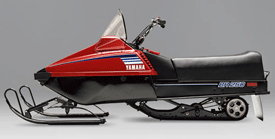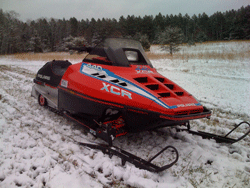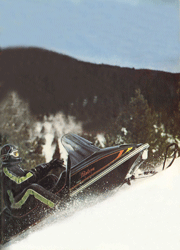Timeline: The Alouette Silver Cloud
Back in the early 1970s, many of us thought the Wankel rotary would re-revolutionize snowmobiling like the two-stroke engine had done in the 1960s. Light and compact with few moving parts, virtually vibration free, quiet for the day and capable of producing more horsepower and greater low-end torque than a heavier two-stroke of similar displacement, the Wankel was popping up in many sled brands.
Perfected by Dr. Felix Wankel of West Germany’s NSU Motorenwerke in the late-1950s, this engine concept is just plain different. It uses a unique three-sided rotor spinning inside a trochoid (think two slightly overlapping circles, sort of like the MasterCard logo) combustion chamber to open the intake port, compress the air-fuel mixture and expel the burned charge.
Germany’s Fichtel-Sachs, one of the snowmobile industry’s primary engine suppliers before the flood of Japanese power, was a leading manufacturer of small Wankels at the time. The company supplied rotaries in modest evaluation quantities to more than a half-dozen sled manufacturers, but quickly realized that it would not be able to meet the demand for the revolutionary powerplant. So Sachs partnered with a few companies. Arctic Cat was its primary rotary engine customer, receiving literally thousands of the engines for snowmobiles and lawnmowers. But Alouette and Skiroule were also allocated significant quantities. It is notable that all three of these companies were pushing the boundaries of snowmobile engineering in various ways, so Wankel power fit them nicely. Meanwhile Outboard Marine Corporation chose to build its own larger and more powerful rotary engines for Evinrude and Johnson brands.
The Silver Special
Alouette received enough of the “Generation II” Sachs Wankels for a pilot build of 500 sleds as a late addition to the 1973 line. Done in the color of the precious metal rather than Alouette’s usual bright red, the first Silver Cloud sold out quickly with minimal marketing push behind it. Sensing that it had a winner, the company positioned the improved 1974 Silver Cloud Mark II right behind the all-new Super Brute at the top of the company’s lineup.
The Silver Cloud had a lot going for it. For openers, the ’74 Alouettes had redesigned steering for better handling and Clouds got additional air intakes to help cool the hot-running rotary. A Mikuni VM-series carburetor provided better starting and reliability than the
old diaphragm pumpers still used on the

Arctic Cat and Skiroule sleds with the same engine.
Snow Goer confirmed that despite a welded steel chassis, the short and smallish Silver Cloud was actually the lightest of all the 1974 Wankels in ready-to-ride condition, an important point considering the relatively modest power available. Interestingly, this was the only steel-chassis Alouette without tunnel stirrups, but that only saved a pound or so.
Underneath, the Silver Cloud featured an improved version of Alouette’s unique Ski-Sorber suspension that some rated as the best front end in the business because it kept the skis down on the snow far better than conventional leaf springs. The rear suspension was yet another fearless Alouette attempt to improve snowmobile engineering, but wasn’t anywhere near as successful as the Ski-Sorber front end. The Trail Rider single slide rail rear suspension with outboard bogie wheels was one of several industry attempts to combine the best of both systems. Although it was adjustable for rider weight, it just wasn’t very stable. Snow Goer said: “rear end side slippage is common at speeds over 40 mph.” But it was “comfortable enough to ride” and commented that the seat was not up to handling heavy riders who could find themselves bottoming out on the under-seat storage compartment.
However, the Silver Cloud was one of the most tip-over resistant sleds tested that spring, with its 47-degree tipping point ranked fourth among 24 models evaluated.

Numerous riders have commented over the years that the Silver Cloud provided smooth, seamless power from take-off through top speed.
Drawbacks and Down Times
For all its positive attributes, the Wankel rotary engine had significant drawbacks. It was a bit pricey, fussy about oil and spark plugs, sometimes hard to start and intolerant of starting ether. It was also thirsty at low power demand. The rotary also produced excessive air intake noise and very hot exhaust that elevated under-hood temperatures and left the pipe glowing red.

But the biggest rotary engine problem was all-too-frequent failure of the rotor’s side seals. And many buyers just weren’t interested in dealing with the idiosyncrasies of this unique engine that was still under development. Consequently many riders avoided Wankel engines, and many more wished that they had done so. Lots of Wankel-engined sleds of all brands ended up on the junk heap at a young age, and by 1976 no snowmobile manufacturer offered Wankel power.
Moreover, Alouette itself was in deep trouble. Chronic industry overproduction, a very light winter in 1974, and the after affects of the Arab oil embargo combined to accelerate the massive shake out of snowmobile manufacturers that was already underway. Alouette lingered on around the edge of the industry for a couple more years, but there were no more Silver Clouds. In fact, there were no more new Alouettes, only some ’74s recycled for 1975 and followed by re-badged Rupps offered only in Canada for 1976.
Alouette was never afraid to be different, never afraid to push the boundaries of snowmobile engineering and never afraid to try new technology, so it’s no surprise that the company built a Wankel-powered snowmobile. But in the end, the combination of Wankel engine issues and the great snowmobile industry meltdown closed the book on the innovative and fearless Canadian manufacturer. And the Alouette Silver Cloud is a very rare bird today.
1974 Alouette Silver Cloud Mark II
Manufacturer: Alouette Recreational Products LTD., a subsidiary of Coleco Limited, Montreal, Quebec
Powertrain Specs
Engine: Sachs KM-24 air-cooled single-chamber rotary with “Elnisil” (aluminum-cadmium) internal surfacing and dual external crankshaft balancers
Displacement: 294cc
Carburetion: One Mikuni VM-30 with ram air tube and external mechanical fuel pump
Ignition: Magneto and breaker points
Lubrication: Pre-mix at 25:1 (special rotary engine formula was suggested)
Exhaust: Single pipe with muffler with heat shield between muffler and engine
Power Output: 23 hp @ 6,000 RPM
Electrical Output: 75 watts
Drive Clutch: Salsbury
Driven Clutch: Salsbury
Chassis Specs
Type: Welded and painted steel with chromed tubular steel bumpers
Weight: Claimed 380 pounds dry; actual 405 pounds wet for prototype tested by Snow Goer
Front Suspension: Alouette Ski-Sorber pivoting coil-over hydraulic shock absorber
Ski Stance: 26.5 inches
Rear Suspension: Alouette Trail Rider single slide rail with hyfax top and bottom, four bogie wheels and two torsion springs on rear bogie shaft
Track: 15-inch polyester-reinforced rubber with single sprocket drive
Brake: H & H mechanical disc
Fuel Capacity: 5 gallons (US)
Standard Equipment: Tachometer, kill switch, under-seat storage compartment, passenger grab strap, non-slip running boards, rear snow flap
Price: $1,299 MSRP excluding freight, set-up and other charges




My father was an Allouette dealer in the 70s and had a Silver Cloud. I remember riding it. If I remember correctly he had to enter a dealers draw to get one. I would buy one today if I could find one just for nostalgic reasons. I have 2 Starcrafts for the same reason.
Don Boyce- I have a silver cloud that I’m restoring at the moment. Let me know how much you are willing to spend and when it’s fully resorted we can make a deal. Could also make a deal for the sled unrestored if you are interested. Email me back at the address provided and we can discuss further.
Thank you,
Terry Ingersoll
d are you still interested in parting with your silver cloud?